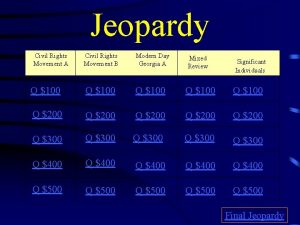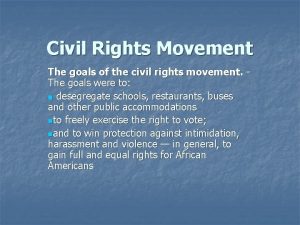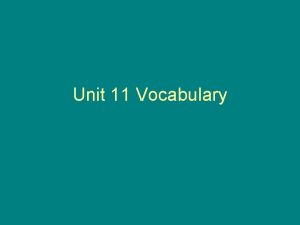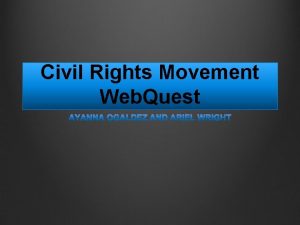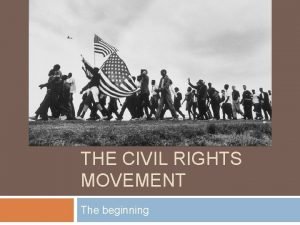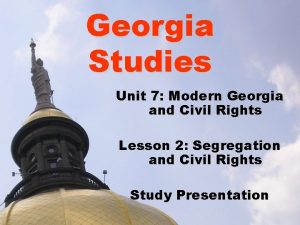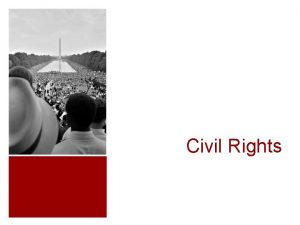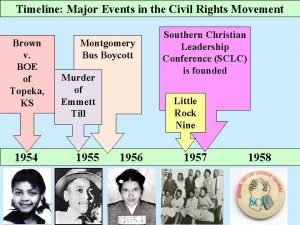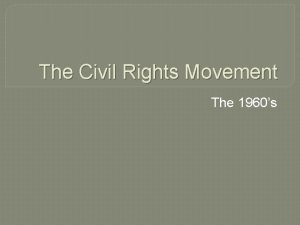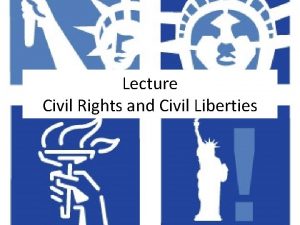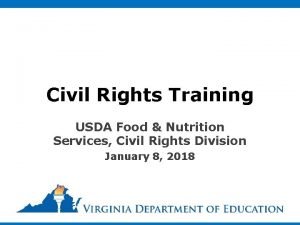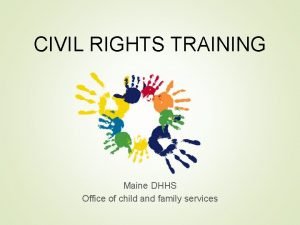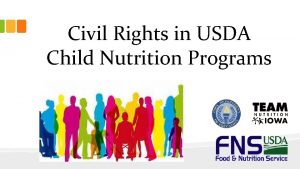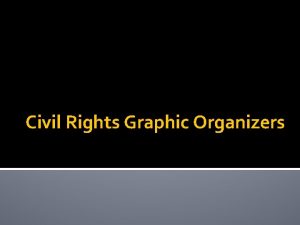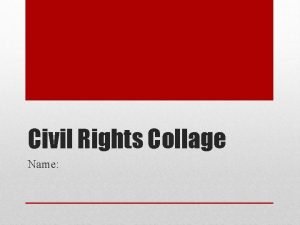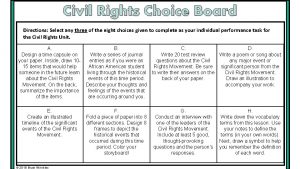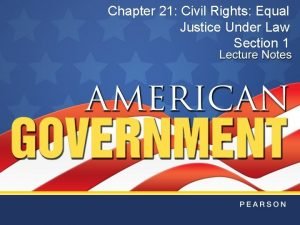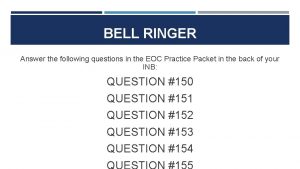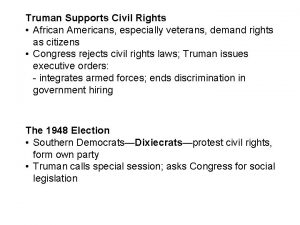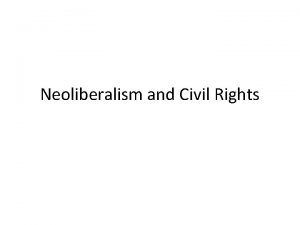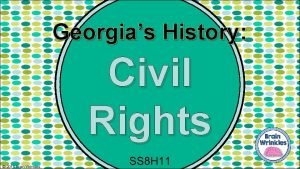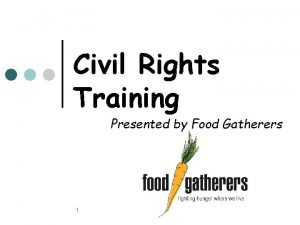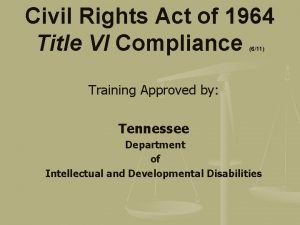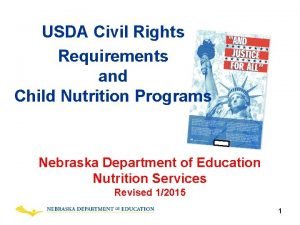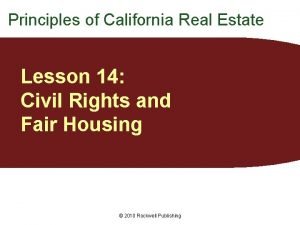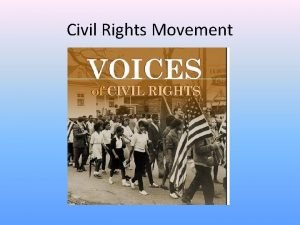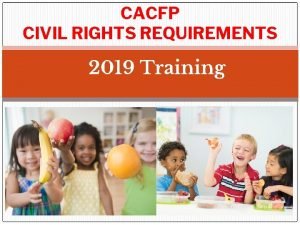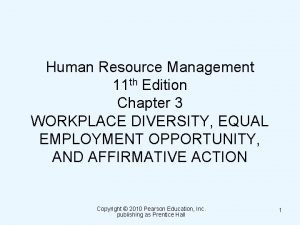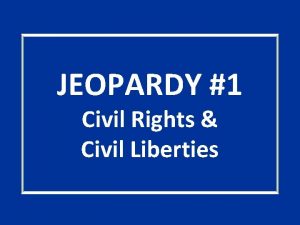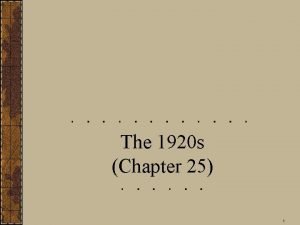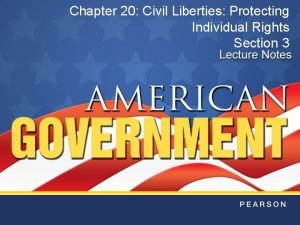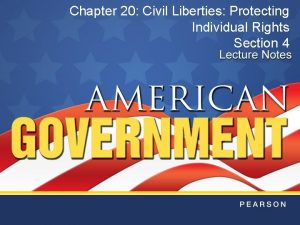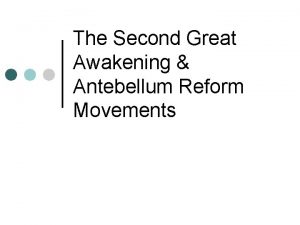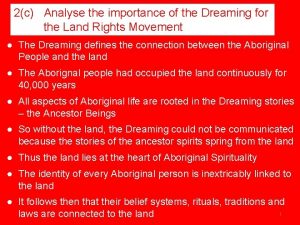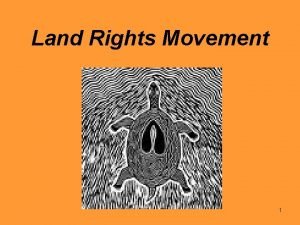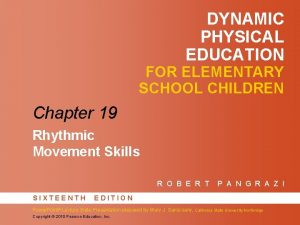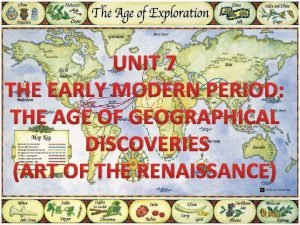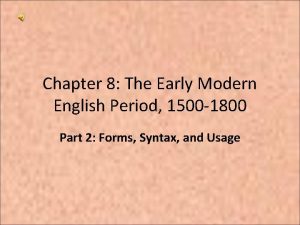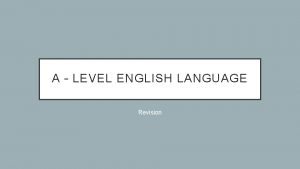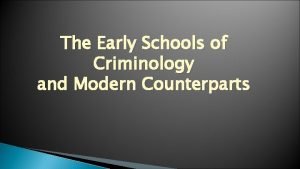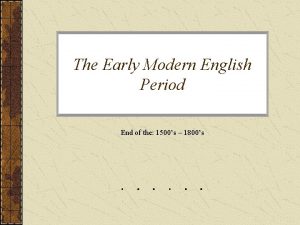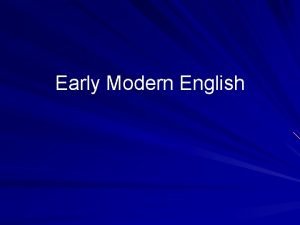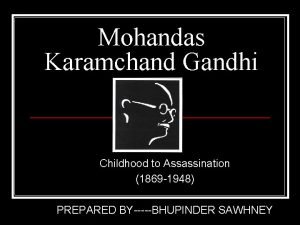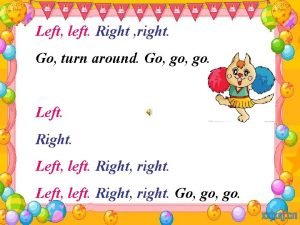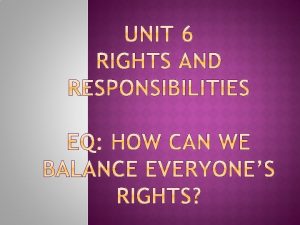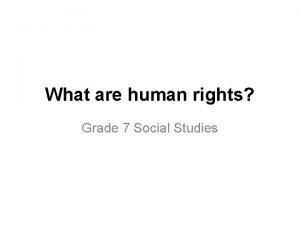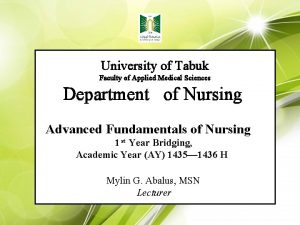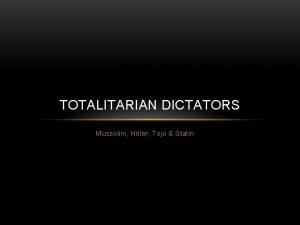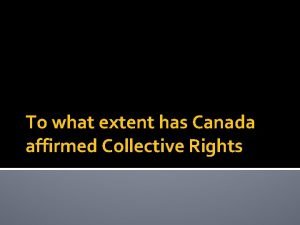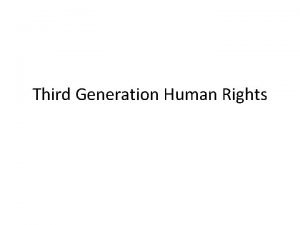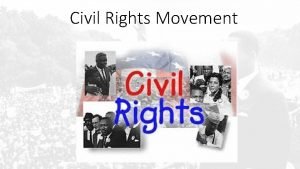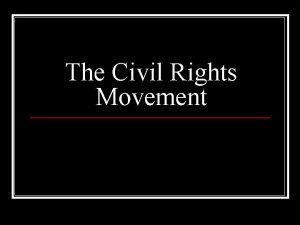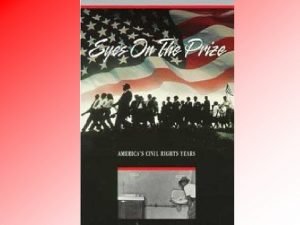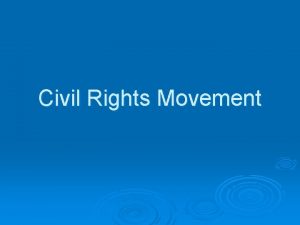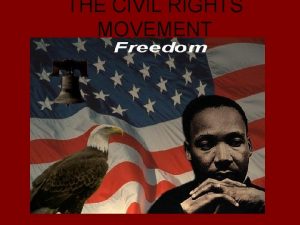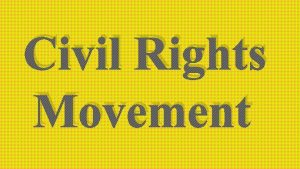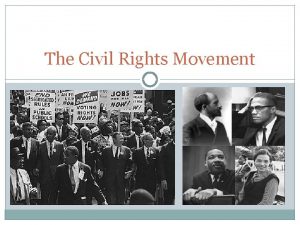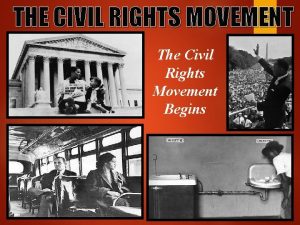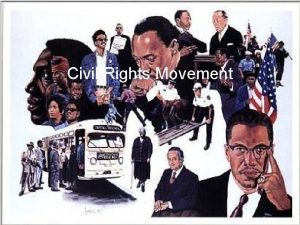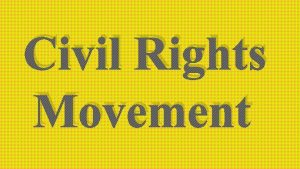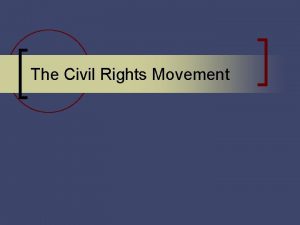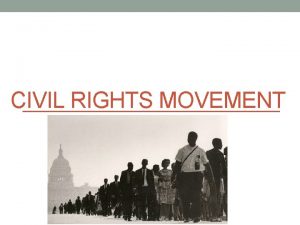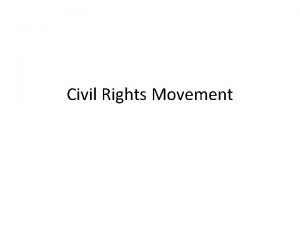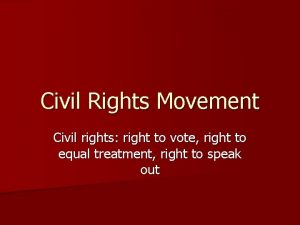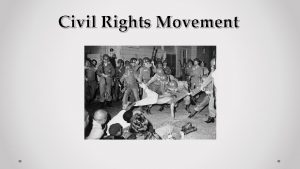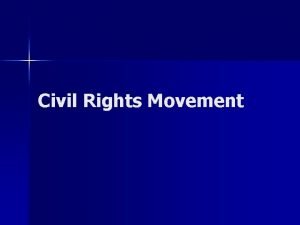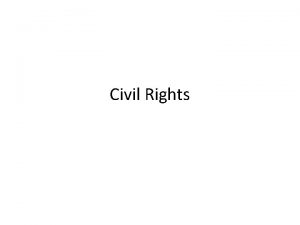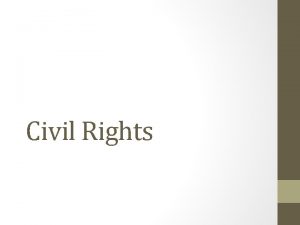Civil Right Movement Early vs Modern Civil Rights

















































































- Slides: 81


Civil Right Movement • Early vs. Modern Civil Rights Movement • Searching for an Identity and Leadership • Leaders, Activities, and Organizations

Civil Right Movement SECTION 1: Taking on Segregation I. The Segregation System A. Plessy v Ferguson 1. 1896 2. “ 14 th amendment does not prevent private organization from discriminating” 3. Legalized Jim Crow Laws – Segregated accommodations were legal provided they were equal 4. “separate but equal”

Civil Right Movement • Booker T. Washington 1. Founder of Tuskegee Institution in 1891 2. Focus – industrial education /learn a skill 3. Vocational jobs to improve economic situation

Civil Right Movement • W. E. B. Du Bois 1. Ph. D. from Harvard 2. Founder of the NAACP in 1910 3. Use courts to fight discrimination 4. Rejected Washington’s ideas

Civil Right Movement • Marcus Garvey 1. Black nationalist 2. United Negro Improvement Association in 1914 3. Stressed racial separation from white 4. Encouraged a return to Africa

Civil Right Movement Segregation Continues into the 20 th Century B. After Civil War, African Americans go north to escape racism 1. North: housing in all-African American areas, whites resent job competition 2. Northern segregation- de facto -by practice and custom (culture)

Civil Right Movement In the 1950 s C. 15 million African Americans living in the United States D. South: Jim Crows laws ruled their lives- dejureby law 1. Legal segregation in schools, parks, transportation, hospitals etc

Civil Right Movement E. Congress of Racial Equality (CORE) 1. Bring about change through peaceful measures= sit ins 2. Founded by in 1942, most members were white and middle class 3. James Farmers – 1 st African American leader 1961 Successfully integrated Public facilities in Chicago, Detroit, Denver, and Syracuse. James Farmer 1920 -1999

Congress of Racial Equality (CORE) • Staged “sit-ins” in public places that refused to serve African Americans.

II. Challenging Segregation in Court A. The NAACP Legal Strategy 1. Charles Hamilton Houston leads NAACP legal campaign 2. Focuses on most glaring inequalities of segregated public education- SEPARATE IS NOT EQUAL 3. Places team of law students under Thurgood Marshall - win 29 out of 32 cases argued before Supreme Court **Support court cases to overturn segregation** Ex: Norris v. Alabama, 1935 = exclusion from juries Morgan v. Virginia, 1946 = segregation on interstate buses Sweatt v. Painter, 1950= state law schools Charles Houston was one of the most important civil rights attorneys in American history. WWI VET

Thurgood Marshall • NAACP chief lawyer who tried to end segregation in schools.

Civil Right Movement B. Brown v Board of Education of Topeka, Kansas, May 17, 1954 (ended decades of segregation in the South) 1. Supreme Court unanimously decided segregation violates the 14 th amendment, strikes down school segregation, unconstitutional 2. Thurgood Marshall argues the case; greatest victory 3. Many schools began integrating =500 in 1 year Brown Family

Brown v. Board of Education of Topeka, Kansas (1954) • Supreme Court case that ruled segregation in the schools was unconstitutional. • Many schools began integrating

Civil Right Movement --Did all schools comply? C. Brown II, orders desegregation at “all deliberate speed” D. Chief Justice Earl Warren appointed to the Supreme Court 1. Warren Court - Brown v. Board of Education of Topeka, KS-1954 overturned Plessy v. Ferguson • Thurgood Marshall first African American on Supreme Court 1967

Thurgood Marshall • NAACP chief lawyer who tried to end segregation in schools.

Civil Right Movement Governor Earl Warren was appointed to the Supreme Court Warren Court – Civil Rights & Rights of the accused Warren Commission. Investigated Kennedy’s assignation

Warren Court Reforms Under Chief Justice Earl Warren, the Supreme Court issued a number of decisions that altered the voting system, expanded due process, and reinterpreted aspects of the First Amendment. A sampling of major decisions of the Warren Court Civil Rights • Brown v. Board of Education (1954) Declared segregation in public schools unconstitutional Due Process • Mapp v. Ohio (1961) Ruled that unlawfully seized evidence cannot be used in a trial • Gideon v. Wainwright (1963) Established suspect’s right to court-appointed attorney if suspects were unable to afford one • Escobedo v. Illinois (1964) Affirmed right of the accused to an attorney during police questioning • Miranda v. Arizona (1966) Required police to inform suspects of their rights during the arrest process Freedom of Speech and Religion • Engel v. Vitale (1962) Banned state-mandated prayer in public schools • Abington School District v. Schempp (1963) Banned state-mandated Bible reading in public schools


III. Integration at Little Rock A. Little Rock, Arkansas- 1957 -school board voted to admit 9 African Americans (Little Rock 9) B. Arkansas Gov. Orval Faubus called National Guard to prevent them from entering Central High=9/4/57 C. Eisenhower sent in Army to restore order and protect the “Little Rock 9” *Troops remain the entire year* D. 1957 Civil Rights Act — federal government power over schools, voting-9/9/57 1 st federal legislation since Reconstruction. Eisenhower sent bill to Congress. With help of LBJ, it passes. Elizabeth Eckford faces abusive crowd when she tries to enter school

U. S. Army protects the 9 students


IV. Montgomery Bus Boycott 1955 -1956 A. Rosa Parks “mother of civil rights movement”challenged the separate-but-equal B. Arrested not giving up seat in white section C. Montgomery Improvement Association formed, organizes bus Boycott 1. Elect 26 -year-old Baptist pastor Martin Luther King, Jr. leader D. African Americans go on strike against bus- Montgomery Bus Boycott - 1955 -1956 E. 1956, Supreme Court outlaws bus Segregation F. Event produced a leader, an organization, technique 1. Martin Luther King Jr. 2. SCLC= Southern Christian Leadership Conference 3. Non-violent civil disobedience – inspired by India’s Gandhi

Rosa Parks • Woman who challenged the separate-but-equal law by sitting in the white section of a city bus in Montgomery, Alabama.

Martin Luther King, Jr.

V. Martin Luther King and the SCLC A. Martin Luther King, JR. used nonviolent resistance “soul force” 1. sit-ins and marches 2. founded Southern Christian Leadership Conference staged protests 3. tried to register African Americans to vote and challenged segregation everywhere B. JFK elected in 1960 supports Martin Luther King

Southern Christian Leadership Conference (SLCC) • Civil Rights group that tried to register African Americans to vote and challenged segregation everywhere. • King was the first president.


VI. The Movement Spreads A. Student Nonviolent Coordination Committee (SNCC) non violence but calls for more confrontational strategy 1. created by students 2. Leader Robert Moses 3. was organized to advance the "sit-in" Movement 4. refuse to leave segregated lunch counter until served B. Influenced by Congress of Racial Equality (CORE) to use sit-ins. ** Also sent volunteers into the South to register African American to vote. Focus on not just urban but also rural areas- Moses >> Voter Education Project**


Civil Right Movement Demonstrating for Freedom C. Woolworth lunch counter in Greensboro, NC, February 1, 1960 1. Greensboro four- SIT IN 2. Not served, segregated 3. first sit in shown nationwide TV D. July, 1960= desegregated lunch counters • By the end of the week over 300 students were participating in the Woolworth sit in • Over 70, 000 people participated in sit-in through out the South

See, Think, Wonder


Civil Right Movement SECTION 2: The Triumphs of a Crusade I. CORE’s Freedom Rides A. Spring of 1961 (Boynton v. Virginia, 1960, case overturned a conviction of an African American law student for trespassing in a bus terminal "whites only". It held that racial segregation in public transportation was illegal and violated the Interstate Commerce Act, which broadly forbade discrimination in interstate passenger transportation) B. SNCC, members joined CORE, encourage the Freedom Rides C. Placed white and black students on interstate busses to test new court decision to desegregate D. In deep South response was violent, many beaten E. Attorney General Robert Kennedy assigned federal marshals to protect riders, Interstate Commerce Commission act: ban segregation in all interstate travel facilities


Civil Right Movement II. Standing Firm A. Integration of “Ole Miss” 1. 29 yr old veteran James Meredith, enroll in all-white University of Mississippi. 1962 2. Arrival touched off riots 3. Gov Ross Barnett refused to allow to register – Announced state laws were superior to federal laws 4. Kennedy ordered Federal troops 5. Riots broke out-2 deaths (1 st federal marshals under orders not to fire, 160 marshals wounded, then thousands of troops; troops remain the year)

Governor Ross Barnett

James Meredith being escorted by federal marshals at Ole Miss

Meredith attempts to register for school

Mobs gather to protest Meredith’s enrollment

U. S. Army enters Oxford

Army uses tear gas to quiet the mob

Meredith graduates from Ole Miss


Civil Right Movement B. Birmingham, Alabama 1. Martin Luther King, Jr. 1. asked to come to the city; 2. Dr. Kings wanted to force Kennedy to openly support Civil Rights April 3, 1963 (concern was federal govt only got involved when things turn violent) 2. Most segregated big city in America 3. King arrested, writes “Letter from Birmingham” – to white religious leaders 4. It was a planned non-violent campaign 5. Police used fire hoses, police dogs and clubs 6. TV carried scene to the nation *Kennedy begins work on Civil Rights Bill)

Civil Right Movement **Shortly after Birmingham shocked the nation Gov Wallace gives Kennedy an opportunity to address the Nation** C. June 1963, JFK sends troops to force Gov. Wallace to desegregate U of AL D. NAACP’s Medger Evers assassinated in Jackson, MS- by Byron De La Beckwith in 1963; hung juries lead to killer’s release was

George Wallace • Governor of Alabama who refused to allow Alabama schools to integrate. • Kennedy announced a Civil Rights bill the same day.

Wallace stands in front of the school door

Civil Right Movement II. March on Washington (Aug 1963) A. to persuade Congress to pass Kennedy’s civil rights bill * Passed the House (Supported by Northern Dems & Repubs) but not the Senate (Southern Dems used a filibuster)* B. 250, 000 marched at Washington C. ‘I have a Dream' speech was made D. JFK was killed in Nov. 22, 1963

I have a Dream

Civil Right Movement E. Civil Rights Act 1. Civil Rights Act of 1957 =Protected African Americans’ right to vote. (Senator LBJ helped get it passed) 2. September, 4, 63 - Birmingham 4 girls killed when bomb thrown into church 3. Two months later Kennedy assassinated –Bill wasn’t close to passing • Southern Democratic Senators had a filibuster going –Johnson addressed Congress • “…couldn’t more eloquently honor Pres. Kennedy’s memory” 4. Civil Rights Act of 1964 passed in June 1964 LBJ signs Civil Rights Act of 1964 -gave govt broad powers to prevent discrimination= prohibits discrimination because of race, religion, gender; libraries, parks, washrooms, restaurants, theaters, other public places- Creates the EEOC, Equal Employment Opportunity Commission

The 16 th Street Baptist Church in Birmingham, Alabama was bombed on Sunday, September 15, 1963

Civil Right Movement • Civil Rights Act of 1964 – Elections: • Prohibited election officials from applying different standards to blacks and whites voting – Public Accommodations: • Forbade discrimination in public places • Forbade discrimination in government owned or operated facilities – Federally Assisted Programs • Allowed the government to withhold aid from states involving discrimination – Employment • Prohibited discriminatory practices by employers, agencies, and labor union • No discriminatory hiring on basis of race, sex , religion or nationality


• The Civil Rights Act of 1964, which ended segregation in public places and banned employment discrimination on the basis of race, color, religion, sex or national origin, is considered one of the crowning legislative achievements of the civil rights movement • Voting Rights Act of 1965 eliminated literacy test.

Civil Right Movement F. 24 th Amendment 1. Passed in 1964 2. Prohibited the use of poll taxes as a requirement for voting in a federal election 2. To prevent disenfranchisementkeeping a certain group from voting

Poll Tax and Literacy Test • Methods used in the south to keep African Americans from voting. Disentrancement= disenfranchisement

Civil Right Movement III. Fighting for Voting Rights A. Freedom Summer 1964—CORE, SNCC project to register African Americans to vote in MS 1. Volunteers beaten, killed; businesses, homes, churches burned New Political Party B. Mississippi Freedom Democratic Party formed to get seat in MS party 1. Fannie Lou Hamer —voice of MFDP at National Convention—wins support 2. LBJ fears losing Southern white vote, pressures leaders to compromise 3. MFDP and SNCC supporters feel betrayed

Neshoba County Killings • Three SNCC workers were killed in Philadelphia, MS while registering voters

Fannie Lou Hamer • Fannie Lou Hamer • SNCC leader who was abused in Mississippi. • Later she organized political parties in Mississippi.

Civil Right Movement C. Voting Act of 1965 1. A result of Selma, Alabama incident 2. Selma, AL-1/2 of population was African American and only 3% were registered voters 3. King leads 600 protest marchers; TV shows police violently stop them; “march for freedom” Selma to Montgomery 4. State troops assaulted demonstrators as they marched to the state capital *LBJ was angry and proposed new voting rights laws* 5. Voting Rights Act of 1965 eliminated literacy test

Civil Right Movement SECTION 3: Challenges and Changes in the Movement I. African Americans Seek Greater Equality (Economic) A. Northern segregation 1. de facto -by practice and custom, problem in the North 2. de jure -by law, Southern segregation 3. north was worse after the war-white flight B. Urban violence 1. 1964 - whites police and African Americans fought in NY-resulting in riots in Harlem 2. after Voting Rights Act was passed- riots broke out in LA, Detriot 3. Watts Riot -while police were arresting a young man they started arguing with the accuser's mother=lasted 6 days, building burned and looted




Civil Right Movement II. African-American Solidarity A. Malcolm X (Little) 1. Nation of Islam- Black Muslims 2. Preached black superiority and separation from whites and armed self defense 3. "Ballots or Bullets” 4. Pilgrimage to Mecca changes Malcolm X’s attitude toward whites 5. Splits with Black Muslims; is assassinated in 1965 while giving speech

Malcolm X

Civil Right Movement B. CORE, SNCC become more militant; SCLC pursues traditional tactics (Movement moves to the North and begins to turn away for Dr King’s teachings; expel white leadership roles; African Americans should determine course and direction) 1. Stokely Carmichael, head of SNCC 1966, calls for Black Power: African Americans control own lives, communities, without whites C. Black Power- Black Panthers 1. political party 2. fight police brutality (self defense) 3. Blacks should take control of community and employment; self-sufficient 4. Exemption from military service 5. Grassroots activities


Civil Right Movement IV. Dr. King’s Death A. April 4, 1968 -MLK was assassinated in Memphis B. James Earl Ray C. King’s death leads to worst urban rioting in U. S. history - over 100 cities affected D. Robert Kennedy was campaigning for presidential nomination E. RFK was shot June 5, 1968 (died June 6, 1968)- assassinated


James Earl Ray • King’s assassin • Was captured in Europe • Died in prison

Civil Right Movement V. Legacy of Civil Rights Movement A. de jure segregation ended B. Civil Rights Act of 1968 was passed; prohibits discrimination in housing sales and rentals- de facto C. More African Americans went to college D. 2/3 were voters E. held public office F. affirmative action -make special efforts to hire groups that have suffered from discrimination 1. 1960 s, colleges, companies doing government business adopt policy

"Darkness cannot drive out darkness; only light can do that. Hate cannot drive out hate; only love can do that. Hate multiplies hate, violence multiplies violence and toughness multiplies toughness in a descending spiral of destruction. The chain reaction of evil………must be broken, or we shall be plunged into the dark abyss of annihilation. " » Martin Luther King Jr.

176. What were the segregation laws in the South called? Jim Crow Laws 177. What Supreme Court decision made segregation legal? Plessy v. Ferguson 178. What Supreme Court decision made school segregation illegal? Brown v. Board of Education 179. What law made segregation in public places illegal? Civil Rights Act of 1964 180. What type of protest did Dr. King lead? nonviolent passive resistance

181. Name two ways Southern states kept African Americans from voting. poll tax and literacy test 182. What was the 24 th Amendment? abolished poll taxes 183. What two protest methods were used the most during the Civil Rights Movement? sit-ins and boycotts 184. What was the 1964 voting registration campaign led by SNCC in the south called? Freedom Summer 185. Name the two organizations most associated with the Civil Rights Movement. SNCC and the SCLC

What laws enforced segregation in the south? Jim Crow Laws

What was significant about the Brown v. Board of Education case? Ended segregation in schools and overturned Plessy v. Ferguson

Who was the first African American admitted into Ole Miss? James Meredith

What two methods were used to keep African Americans from voting? Poll tax and literacy test

What was the militant African American group that believed a revolution was necessary for blacks to gain true power? Black Panthers
 Mother of the modern day civil rights movement
Mother of the modern day civil rights movement Right product right place right time right price
Right product right place right time right price Family time
Family time Civil rights and civil liberties webquest
Civil rights and civil liberties webquest Civil rights movement jeopardy
Civil rights movement jeopardy Goals of the civil rights movement
Goals of the civil rights movement Civil rights movement vocabulary
Civil rights movement vocabulary Civil rights movement webquest
Civil rights movement webquest The civil rights movement
The civil rights movement Civil rights movement essential questions
Civil rights movement essential questions Unit 7: modern ga and civil rights
Unit 7: modern ga and civil rights Civil right movement def
Civil right movement def The right man on the right place at the right time
The right man on the right place at the right time Positive rights and negative rights
Positive rights and negative rights Riparian rights vs littoral rights
Riparian rights vs littoral rights Conclusion of rights
Conclusion of rights Legal rights vs moral rights
Legal rights vs moral rights Positive and negative rights
Positive and negative rights Positive vs negative rights
Positive vs negative rights Negative right
Negative right Negative right
Negative right Civil rights timeline of events
Civil rights timeline of events Civil rights sitins
Civil rights sitins Montgomery bus boycott apush
Montgomery bus boycott apush Right to die
Right to die Usda civil rights training
Usda civil rights training Civil rights training certificate
Civil rights training certificate Civil rights in child nutrition programs
Civil rights in child nutrition programs Civil rights graphic organizer
Civil rights graphic organizer Civil rights leaders collage
Civil rights leaders collage Civil rights choice board
Civil rights choice board Chapter 21 civil rights equal justice under law
Chapter 21 civil rights equal justice under law Chapter 20 civil liberties protecting individual rights
Chapter 20 civil liberties protecting individual rights Civil rights bell ringers
Civil rights bell ringers Truman supports civil rights
Truman supports civil rights Characteristics of civil rights
Characteristics of civil rights Civil rights cloze notes 1
Civil rights cloze notes 1 Civil rights cloze notes
Civil rights cloze notes Civil rights training quiz answers
Civil rights training quiz answers Title vi of the civil rights act of 1964
Title vi of the civil rights act of 1964 Civil rights in child nutrition programs
Civil rights in child nutrition programs Unruh civil rights act real estate
Unruh civil rights act real estate Civil rights movment
Civil rights movment Cacfp civil rights
Cacfp civil rights Title vii of the civil rights act
Title vii of the civil rights act Title vii of the civil rights act
Title vii of the civil rights act Civil rights jeopardy
Civil rights jeopardy Chapter 14 postwar prosperity and civil rights
Chapter 14 postwar prosperity and civil rights What did the civil rights act of 1875 do
What did the civil rights act of 1875 do Chapter 20 civil liberties protecting individual rights
Chapter 20 civil liberties protecting individual rights Chapter 20 civil liberties protecting individual rights
Chapter 20 civil liberties protecting individual rights Early cpr and early defibrillation can: *
Early cpr and early defibrillation can: * Women's rights movement
Women's rights movement Importance of the dreaming for the land rights movement
Importance of the dreaming for the land rights movement Dreamtime.net.au
Dreamtime.net.au Pearson education
Pearson education Early modern period dates
Early modern period dates British literary movements timeline
British literary movements timeline Early modern english syntax
Early modern english syntax Early modern english
Early modern english A level english language frameworks
A level english language frameworks Charles goring vs lombroso
Charles goring vs lombroso Early modern english period
Early modern english period Modern english time period
Modern english time period Program of civil disobedience movement
Program of civil disobedience movement Movement and non movement area
Movement and non movement area What is an axial movement
What is an axial movement I got up early one morning and rushed right into the day
I got up early one morning and rushed right into the day Why was the civil war considered the first modern war
Why was the civil war considered the first modern war Get in the train
Get in the train You put your right foot in you put your right foot out
You put your right foot in you put your right foot out Left left right right go go go
Left left right right go go go Rights vs privileges
Rights vs privileges Human rights grade 7
Human rights grade 7 Child rights act 2005 images
Child rights act 2005 images 10 rights of medication
10 rights of medication Rights and responsibilities
Rights and responsibilities Trade-related aspects of intellectual property rights
Trade-related aspects of intellectual property rights What goals did tojo have about territorial expansion
What goals did tojo have about territorial expansion To what extent has canada affirmed collective rights
To what extent has canada affirmed collective rights 1st generation rights
1st generation rights Human rights theory
Human rights theory




